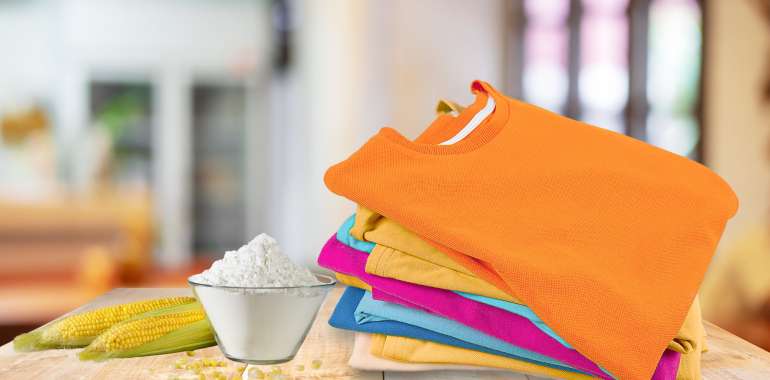Introduction to Starch in Cotton Fabric Production
The use of starch in cotton fabric production is a time-tested fake Audemars Piguet technique that enhances the quality and efficiency of the manufacturing process.
Starch, a natural polysaccharide, has been utilized in the textile industry for decades due to its unique properties and benefits.
In this article let us explore the role of starch in cotton fabric hublot replica watches uk production, highlighting its importance in improving fabric quality, production efficiency, and meeting environmental standards.
What is Starch?
Starch is a carbohydrate consisting of a large number of Hublot replica watches for sale glucose units joined by glycosidic bonds. It is produced by most green plants as an energy store.
Common sources of starch include corn, potatoes, rice, and wheat. In the textile industry, starch is valued for its adhesive properties, which make it an excellent binding agent in the production of fabrics.

Why Use Starch in Fabric Production?
Starch is used in fabric production primarily because of its ability to improve the mechanical properties of cotton fibres, enhancing the overall quality of the final product.
Its natural adhesive properties make it ideal for stiffening fabrics and providing a smooth finish, which is crucial in the textile industry. High-Quality Replica Watches UK – Best Fake Watch Expert
Additionally, starch helps in the sizing process, where it acts as a protective layer for yarns during weaving, reducing breakage and improving efficiency.
Key Benefits of Using Starch in Cotton Fabric
Improved Fabric Strength
One of the primary benefits of using starch in cotton fabric production is the improvement in fabric strength. Starch forms a film around the cotton fibers, which enhances their tensile strength and durability. This results in fabrics that are more resistant to wear and tear, increasing their lifespan and maintaining their quality over time. 2025 Cheap Replica Watches Uk Online For Sale | Rolex Replica
Enhanced Production Efficiency
Starch plays a crucial role in enhancing production efficiency. During the weaving process, the application of starch to the yarns helps reduce friction and breakage, leading to fewer interruptions and a smoother production flow. This not only increases the speed of production but also reduces wastage, making the process more cost-effective.
Environmental Benefits
With growing concerns about environmental sustainability, the use of natural starch in fabric production is seen as a more eco-friendly option compared to synthetic binders. Starch is biodegradable and derived from renewable sources, making it a sustainable choice for the textile industry. Additionally, the use of starch can help reduce the environmental impact of textile manufacturing by minimizing the need for harmful chemicals.Best Replica Watches UK Sale– Swiss Rolex Clone Watches UK
Types of Starch Used in Fabric Production
Natural vs. Modified Starch
Natural starch, extracted from plants like corn and potatoes, is commonly used in fabric production.
However, modified starches, which are chemically or physically altered to enhance their properties, are also widely used.
These modifications can improve the adhesive strength, stability, and water resistance of starch, making it more suitable for specific applications in textile manufacturing.
Specialty Starches for Cotton Fabric
There are various speciality starches designed specifically for cotton fabric production.
These include cationic starch, which enhances dye uptake and colour retention, and cross-linked starch, which provides improved film strength and durability.
The choice of starch depends on the specific requirements of the fabric being produced.
Where are starch used?
Numerous textile manufacturers have successfully integrated starch into their production processes. For instance, a leading cotton fabric producer reported a 20% increase in production efficiency and a significant reduction in yarn breakage after switching to a starch-based sizing agent. Another case study highlighted the use of modified starch in producing high-quality denim, resulting in fabrics with superior strength and finish.
Analysis with Other Fabrics
When comparing fabrics produced with and without starch, the advantages become evident.
Starch-treated fabrics exhibit better tensile strength, reduced pilling, and improved colour retention.
These benefits make starch an indispensable component in the production of high-quality cotton fabrics.
Future Trends in Starch Use in the Textile Industry
Innovations in Starch Formulations
The textile industry is continuously evolving, and innovations in starch formulations are at the forefront of this change.
Researchers are exploring new ways to enhance the properties of starch, such as developing starch-based nanocomposites that offer superior strength and durability.
These advancements could lead to even greater improvements in fabric quality and production efficiency.
Regulatory and Environmental Impacts
As environmental regulations become more stringent, the use of eco-friendly materials like starch will likely increase.
The industry is moving towards sustainable practices, and starch, with its biodegradability and renewability, aligns well with these goals.
Future trends may also see a rise in the use of organic starches, further reducing the environmental footprint of textile production.
Conclusion
The role of starch in improving cotton fabric production is undeniable. From enhancing fabric strength and production efficiency to providing environmental benefits, starch is a valuable component in the textile industry.
As innovations continue to emerge and sustainability becomes a priority, the use of starch is expected to grow, driving further advancements in fabric quality and production processes.
Cotton fabric producers may meet the demands of both industry experts and environmentally conscientious customers by combining starch into the production process to produce fabrics of higher quality and greater sustainability.
Looking for the best starch manufacturer for cotton fabrics?
Angel Starch is the best place!
FAQs
- What types of starch are best for cotton fabric production?
Natural starches like corn and potato starch, as well as modified starches such as cationic and cross-linked starch, are commonly used in cotton fabric production.
- How does starch affect the environmental impact of fabric production?
Starch is biodegradable and derived from renewable sources, making it a more sustainable choice compared to synthetic binders, thereby reducing the environmental impact.
- Can starch be used in all types of fabric production?
While starch is primarily used in cotton fabric production, it can also be applied to other natural fibres. However, its suitability for synthetic fabrics may be limited.


13 Comments